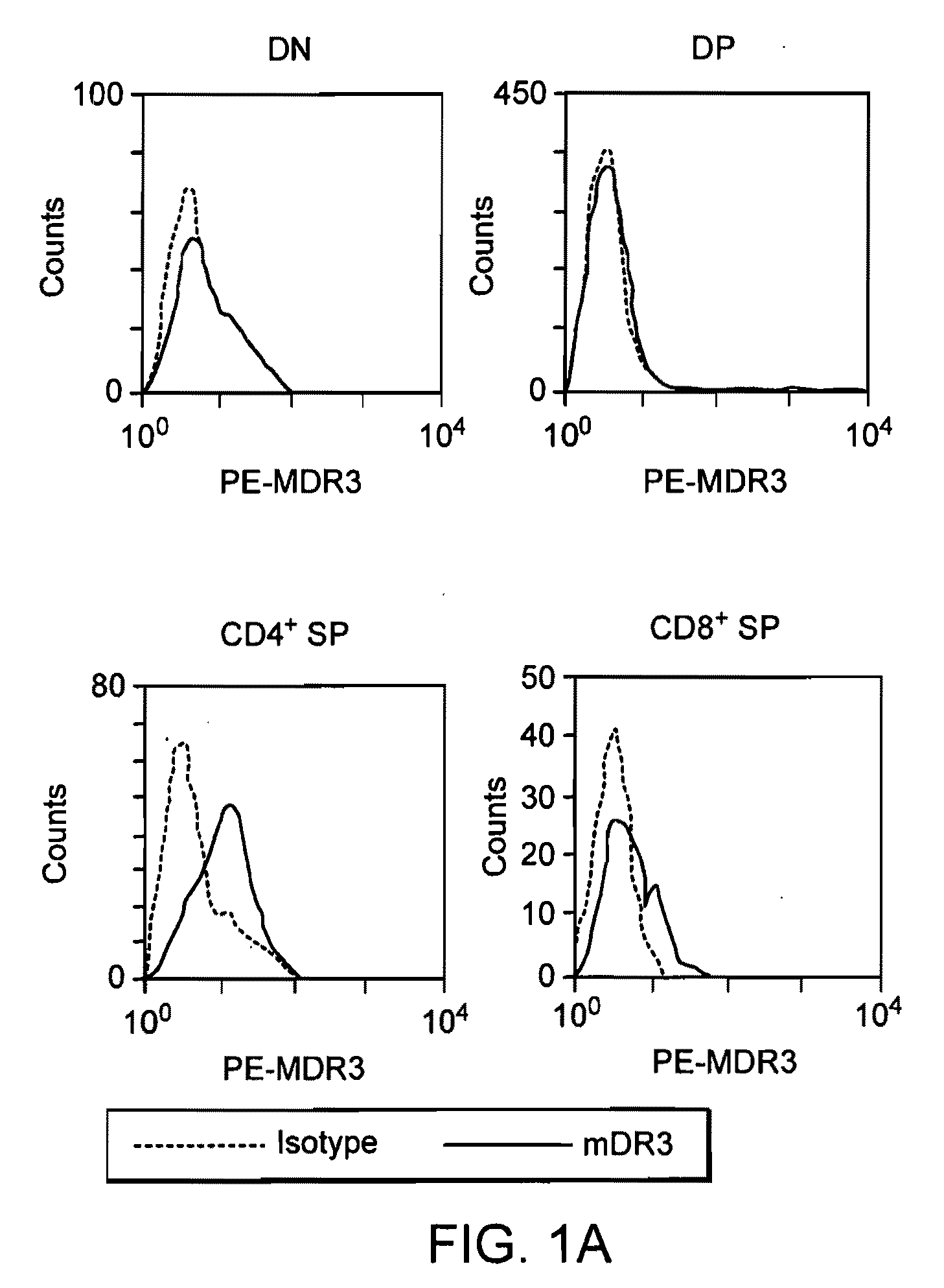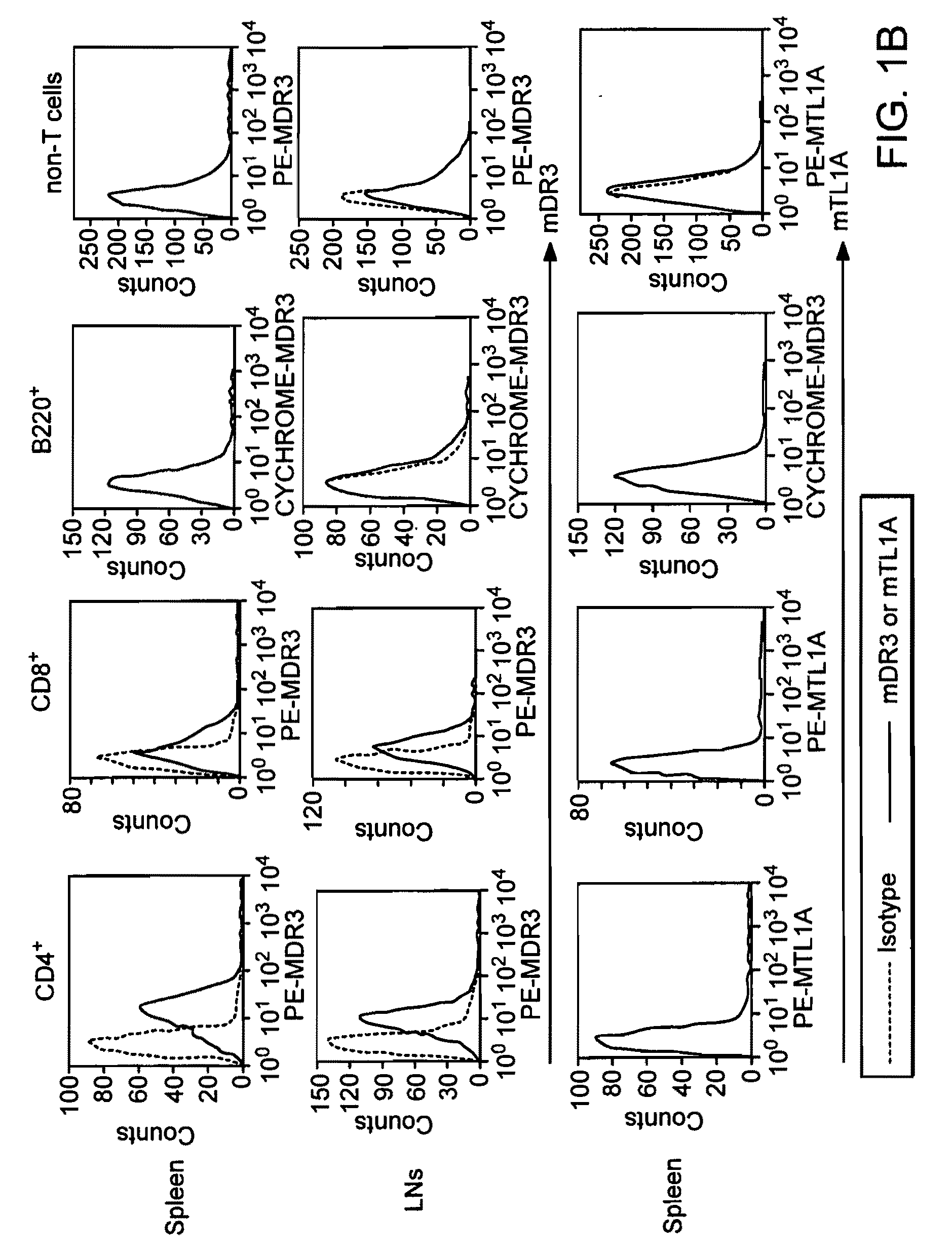Compositions and methods for treating inflammatory lung disease
a technology for inflammatory lung disease and compositions, applied in the direction of immunoglobulins, peptides, drugs against animals/humans, etc., can solve the problems of chronic infection and cancer, irreversible anatomical changes, permanent loss of pulmonary function, hyperresponsive airway to trigger stimuli, etc., to reduce the activity of dr3 or cd30 and il-13 expression.
- Summary
- Abstract
- Description
- Claims
- Application Information
AI Technical Summary
Benefits of technology
Problems solved by technology
Method used
Image
Examples
example 1
Generation and Characterization of DR3 Transgenic Mice
[0108] Materials and methods: Mice. All mice were used at 6-12 weeks of age and were maintained in pathogen-free facilities in accordance with the guidelines of University of Miami Animal Care and Use Committee.
[0109] Media and Reagents. Cells were cultured in Iscove's Modified Dulbecco's Minimal Essential Medium (Invitrogen, Carlsbad, Calif.) supplemented with 10% heat-inactivated FBS (Invitrogen), 10 μg / ml gentamycin (Invitrogen), and 50 μM ∃-mercaptoethanol (Bio-Rad). Monoclonal anti-mouse CD3 and anti-human CD3 were purified from culture supernatants of the 2C11 and the OKT3 cell lines, respectively (ATCC, Manassas, Va.). Monoclonal anti-mouse CD28 and anti-human CD28 were purchased from eBioscience (San Diego, Calif.). Concanavalin A (ConA), phytohemagglutinin (PHA), and lipopolysaccharide (LPS) were from Sigma (St. Louis, Mo.). Recombinant murine IL-2 was from BioSource International (Camarillo, Calif.). Phorbol-12-myrist...
example 2
DR3Transgenic Mouse Model of Lung Inflammation
[0133] DR3 and TL1A expression in activated lymphocytes. DR3 mRNA exists in randomly spliced forms in resting lymphocytes. Small amounts of DR3 protein are found on resting CD4 and CD8 cells. No TL1A mRNA is detected in resting cells from adult mice or human beings. When activated with anti-CD3 and anti-CD28, full-length DR3 mRNA and protein is upregulated rapidly in both CD4+ and CD8+ T cells by correct mRNA splicing. T cell activation also results in TL1A protein expression; activated B cells do not express DR3 or TL1A protein. To study mouse DR3 and TL1A expression and signaling on a protein level, monoclonal antibodies were developed using recombinant mDR3-Ig and MBP (maltose binding protein)-TL1A fusion proteins as antigens for immunization and hybridoma screening. Both anti-DR3 and anti-TL1A hybridoma supernatants or purified antibodies can be used for flow cytometry and immunohistochemistry on frozen sections. In addition, the an...
example 3
Dominant Negative DR3Transgene
[0142] Blockade of DR3 signals by dominant negative DN-DR3 transgenes on T cells blocks Th2 polarization. CD4 cells were purified by negative selection and were activated with immobilized anti-mouse CD3 (2 μg / ml) and soluble anti-mouse CD28 (1 μg / ml). Supernatants were collected after a 3-day culture for the primary response. The cells were washed, replated and reactivated with immobilized anti-mouse CD3 (1 g / ml) for two days.
[0143] Referring to FIG. 14, transgenic full-length FL-DR3 overexpression on T cells caused increased Th2 cytokine production during primary activation. Purified CD4 cells from w.t., (open bar) FL-DR3 transgenic mice (black) and dominant negative DR3 transgenic (gray) mice were activated for three days with anti-CD3 and anti-CD28. After 72 h, supernatants were harvested and analyzed (A). The cells were washed and replated on anti CD3 for an additional 48 h before analysis of the supernatants (B). Note the different y-axes in seco...
PUM
| Property | Measurement | Unit |
|---|---|---|
| time | aaaaa | aaaaa |
| temperature | aaaaa | aaaaa |
| soluble | aaaaa | aaaaa |
Abstract
Description
Claims
Application Information
 Login to View More
Login to View More - R&D
- Intellectual Property
- Life Sciences
- Materials
- Tech Scout
- Unparalleled Data Quality
- Higher Quality Content
- 60% Fewer Hallucinations
Browse by: Latest US Patents, China's latest patents, Technical Efficacy Thesaurus, Application Domain, Technology Topic, Popular Technical Reports.
© 2025 PatSnap. All rights reserved.Legal|Privacy policy|Modern Slavery Act Transparency Statement|Sitemap|About US| Contact US: help@patsnap.com



